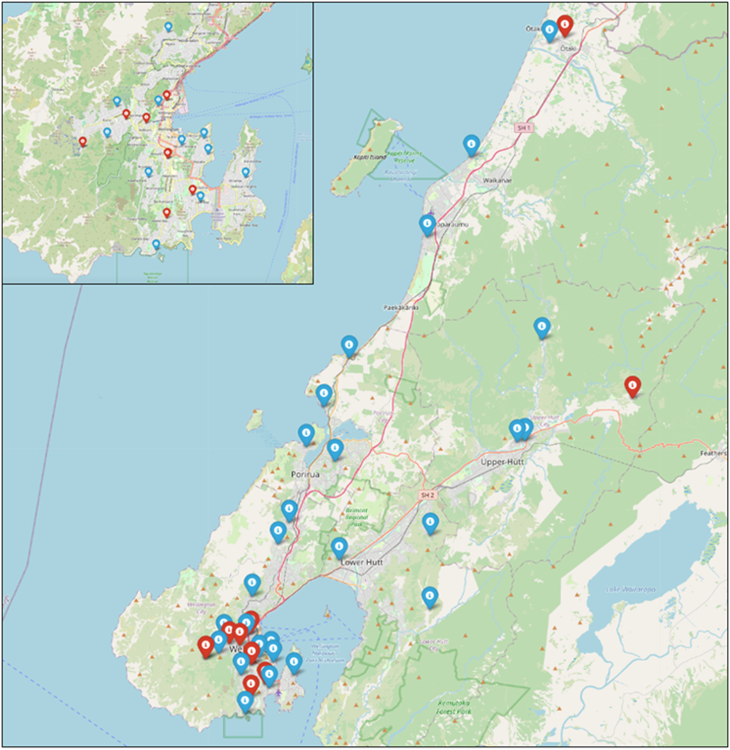Quake-Ready Wellington: Amplifying Earthquake Preparedness with Phase Two Sensor Installation
- ddissanayakamudiya0
- Apr 15, 2024
- 3 min read
The recent completion of the second phase in deploying ground motion sensors marks a pivotal advancement in CRISiSLab's mission to bolster earthquake preparedness within the Wellington region. This endeavour represents a significant stride in our experimental community-engaged Earthquake Early Warning (EEW) network, showcasing the power of collaboration and technological innovation.
Our initiative embarked on a journey with a comprehensive engagement strategy designed to connect with the Wellington community. This outreach was spearheaded by a widespread social media campaign, which effectively mobilised community participation in our earthquake preparedness efforts. The campaign was visually anchored by a flyer, depicted in the figure below, which invited community members to join our mission by installing ground motion sensors within their homes.
The campaign's success was marked by an overwhelming response, as 80 households came forward to partake in this critical endeavour. This sensor installation phase not only broadened our network's reach but also fortified our ties with the community, highlighting the shared responsibility we hold in bolstering disaster readiness. To illustrate the widespread support, figure below maps out the locations of these responsive households, ready to integrate ground motion sensors.
This concerted effort reflects a significant stride toward realising our vision for a community engaged EEW network. Wellington residents' active participation and support are pivotal in advancing this project.
The selection of 25 new sensor locations from the pool of respondents was approached with meticulous consideration, incorporating a blend of algorithmic requirements, seismic analysis, and community input. This strategic process ensures our network is optimized for accurate, timely earthquake detection and alert dissemination. First, algorithmic enhancement plays a crucial role, as we've adopted the EEW algorithm, introducing a two-station trigger mechanism to our network. This advancement significantly minimizes false alerts, enhancing the system's reliability for our community. Secondly, our analysis of seismic activity over the past two decades informed our sensor placement, ensuring a focus on areas with heightened seismic risks. Thirdly, strategic sensor deployment was guided by factors such as fault line proximity, population density, and the geographic distribution of community interest, ensuring comprehensive coverage and efficient alert capabilities. Finally, technical and site considerations were paramount. Our sensor installation strategy underwent a rigorous assessment of site suitability and environmental conditions, ensuring that each sensor is positioned to deliver accurate, reliable data. This holistic approach guarantees that Wellington is better equipped than ever before to face seismic challenges head-on.
The fulfilment of this phase in our project is not just about enhancing the sensor network but also about celebrating the special moments of collaboration and inclusion within the community. A particular highlight of this phase was the unique opportunity to install a sensor at the Whakarongotai Marae. This installation is more than a technological achievement; it symbolises the trust and partnership between CRISiSLab and the local communities we serve. The figure below captures a memorable moment of the CRISiSLab team presenting the sensor to the Marae trustees, a testament to our project's collaborative spirit.
Further illustrating the success of our initiative, the Figure below provides a comprehensive view of the sensor network after phase 2. The map showcases the new sensor locations, marked with blue icons, alongside the existing sensors from phase 1, depicted with red icons. This visual representation underscores our strategic approach to expanding the earthquake monitoring network across Wellington, ensuring a balanced distribution that leverages technological advancements and community engagement.
This initiative is a profound example of what can be achieved when the community and technology converge in pursuing a common goal. By integrating community input with cutting-edge technology and scientific research, we have taken a significant step towards enhancing the earthquake preparedness of the Wellington region.
As we move forward, CRISiSLab remains dedicated to advancing our EEW capabilities, fostering a safer, more resilient Wellington. We extend our deepest gratitude to all participants and stakeholders involved in this monumental effort and look forward to our continued collaboration in pursuing disaster preparedness and resilience.








Comments